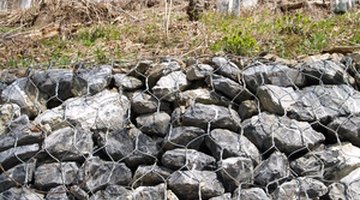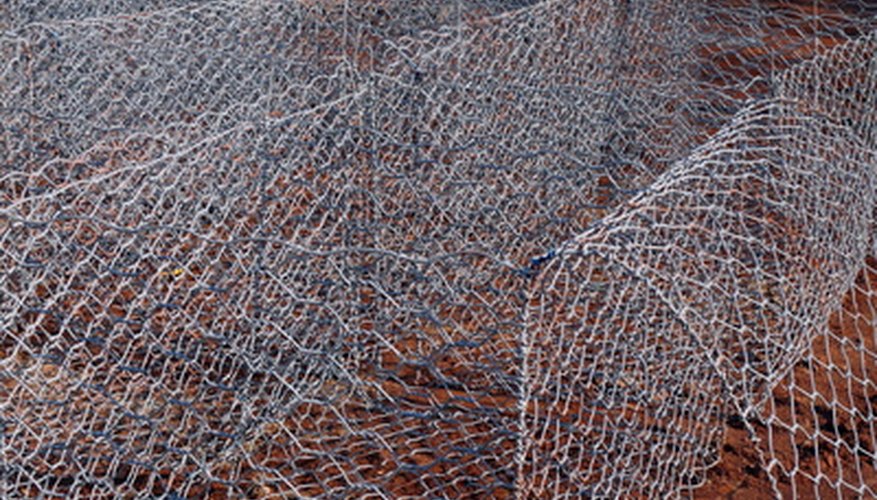It is a good idea to consult a geotechnical or civil engineer before attempting to construct or anchor any type of lateral earth support structure. Know how the earth moves so that any retaining wall you construct or anchor, including a gabion wall, is capable of handling stress. Types of soils, soil stability, soil mechanics and seismic hazards affect an anchored gabion wall and other similar retaining walls.
- It is a good idea to consult a geotechnical or civil engineer before attempting to construct or anchor any type of lateral earth support structure.
- Know how the earth moves so that any retaining wall you construct or anchor, including a gabion wall, is capable of handling stress.

Strip away the first layer of soil until suitable bearing capacity soil is reached. Cut, fill and grade the foundation to receive gabions according to grades specified on drawings or as otherwise desired. Sub-grade should be inspected and approved by an engineer. Site and foundation conditions and soil requirements will vary. Complete assembly of the gabion basket. Unfold the basket, install the gabion diaphragm and fasten edges using spiral binders to join edges and for attaching diaphragms to base panels. Lay the baskets in the foundation.
Permanently attach the first layer of baskets with spiral binders and crimp at every corner (full height of basket). Repeat this procedure for both edges of all diaphragms. Use corner stiffeners -- 30 cm (1 foot) centres across corners diagonally -- for anchoring walls 90 cm (3 feet) or higher. Ensure the first course is aligned properly. Load fill material in first course of gabions. This material should always be specified by an engineer to ensure it can withstand forces placed against it. Level stone so fill material height is consistent for each course. Close lids and bind all edges including tops of diaphragms. Backfill and tamp fill behind each course.
- Permanently attach the first layer of baskets with spiral binders and crimp at every corner (full height of basket).
- Load fill material in first course of gabions.
Stagger vertical joints by at least one half of a basket's length and step back the second course of gabion baskets. Bind the second course of empty baskets' bottom edges to the first course. Repeat the procedure for fastening baskets and filling for each additional course until the specified height of wall is achieved. Complete the interconnection of each course ensuring that any fastening device used is properly spaced diagonally, horizontally or vertically, in order to meet specified requirements.
TIP
Investigate and test soil prior to anchoring gabion wall. Crimp corner stiffeners closed at both ends and ensure they are hooked over crossing wires. Soil stabilising, welded wire mesh layers are used to attach gabions to backfill. Front or back stepping of gabion walls is acceptable. Interior diaphragms should be used when baskets are thicker than 30 cm (12 inches) and interior spaces exceed 90 cm (3 feet) in length. Wire material and method of spacing (lacing, welded mesh, spiral binders) used to fasten and anchor gabions should meet or exceed ASTM and other standard industry requirements. Modular block faced wall systems are available for use with gabion walls and offer a more appealing and uniform wall. End panels that abut another basket can be eliminated. Similarly, the top of a gabion basket can serve as the bottom of another when stacking courses. Gabion baskets come in roll form, precut panels, (rolls and precut panels are cut and assembled in field) or partially assembled.
WARNING
While fill material can be machine-placed in gabions -- 30 cm (12 inch) lifts at certain heights, hand disbursement should be employed as well to reduce voids. Hand disbursement will also add to the aesthetics of the wall. Attach stiffeners or other wire during the fill process to maintain shape and gabion integrity. Install support for gabions left temporarily unrestrained.
